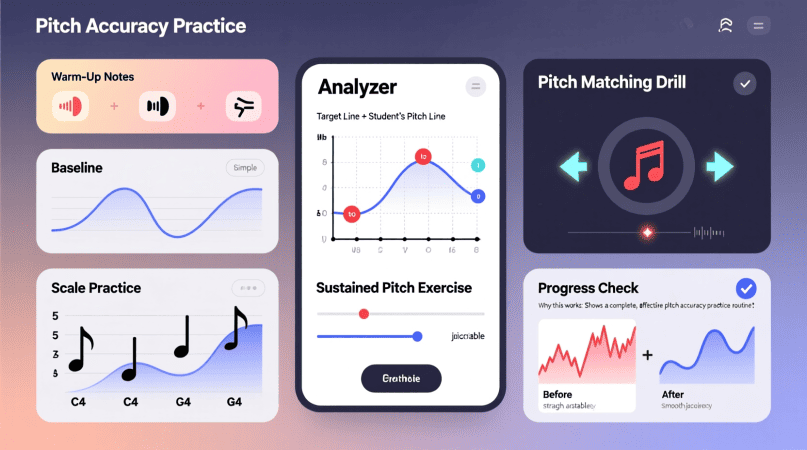
The Voice Pitch Analyzer is more than just a tool to check if you’re in tune — it’s a training partner for building better pitch control, intonation, and ear training.
In this guide, you’ll learn practical exercises to use with the Voice Pitch Analyzer to improve your singing accuracy step by step.
Why Pitch Accuracy Matters
Singing in tune isn’t just about hitting the right note once — it’s about holding it steadily, connecting notes smoothly, and developing muscle memory for accurate pitch production.
The Voice Pitch Analyzer helps by giving you real-time visual feedback so you can see exactly how close you are in ±cents while singing.
How to Use the Voice Pitch Analyzer for Practice
- Open the Voice Pitch Analyzer in your browser.
- Allow microphone access when prompted.
- Start in a quiet room with minimal echo.
- Sing or hum single notes, scales, or exercises slowly and steadily.
- Watch the note name and ±cents reading for immediate feedback.
Exercise 1: Steady Note Hold
Goal: Develop pitch stability.
Steps:
- Sing one note (e.g., A4) for 3–5 seconds.
- Keep the ±cents reading within 0–5¢ for the entire note.
- Repeat across your vocal range.
Tip: This builds vocal support and pitch awareness simultaneously.
Exercise 2: Scale Accuracy Training
Goal: Improve intonation across scales.
Steps:
- Sing do-re-mi ascending, then descending.
- Pause on each note until the ±cents reading stabilizes.
- Start slow; gradually increase tempo over time.
Exercise 3: Interval Jumps
Goal: Train your ear for melodic leaps.
Steps:
- Sing C → E → G → C (octave jumps).
- Check each pitch on the Voice Pitch Analyzer for ±cents accuracy.
- Practice 3rds, 5ths, and octaves for variety.
Exercise 4: Vibrato Control
Goal: Develop even, controlled vibrato.
Steps:
- Sing a note and add natural vibrato.
- Watch how the ±cents meter oscillates.
- Aim for consistent vibrato width and speed.
Exercise 5: Breath & Tone Consistency
Goal: Reduce pitch drift caused by breath changes.
Steps:
- Sing medium-length phrases (5–8 seconds).
- Keep pitch steady from start to finish.
- Focus on breath support to avoid sagging at the end.
Quick Recap Table
| Exercise Name | Focus Area | Goal |
|---|---|---|
| Steady Note Hold | Pitch Stability | Keep ±cents near 0¢ |
| Scale Accuracy | Intonation Across Range | Smooth scale transitions |
| Interval Jumps | Ear Training | Leap accuracy on wide jumps |
| Vibrato Control | Expression Control | Even, consistent vibrato |
| Breath Consistency | Support & Tone | Steady pitch during phrases |
Common Issues & Fixes
- Pitch flicker? See our guide: Pitch Flicker: 9 Causes & Fixes.
- High note dropouts? Read: Whistle & High Register Detection Tips.
- Weak tone readings? Use vowels like ah or oo for stronger fundamentals.
FAQs
1. How long should I practice each day?
Start with 10–15 minutes of focused exercises, 3–4 times per week.
2. Can I save my recordings?
Not in the browser version, but you can record separately and analyze files using the Audio-File Pitch Detector.
3. Is ±cents accuracy more important than hitting the right note?
Both matter — hitting the right note first, then stabilizing it using ±cents feedback.
4. Do these exercises work for choirs?
Yes, singers can practice individually, then combine for group intonation work.
Final Thoughts
With structured practice, the Voice Pitch Analyzer becomes a powerful ally in improving pitch accuracy.
Whether you’re a solo singer, choir member, or vocal coach, these exercises build confidence, ear training, and technical control — all with real-time visual feedback.
Pitch Detector is a project by Ornella, blending audio engineering and web technology to deliver precise, real-time pitch detection through your browser. Designed for musicians, producers, and learners who want fast, accurate tuning without installing any software.
